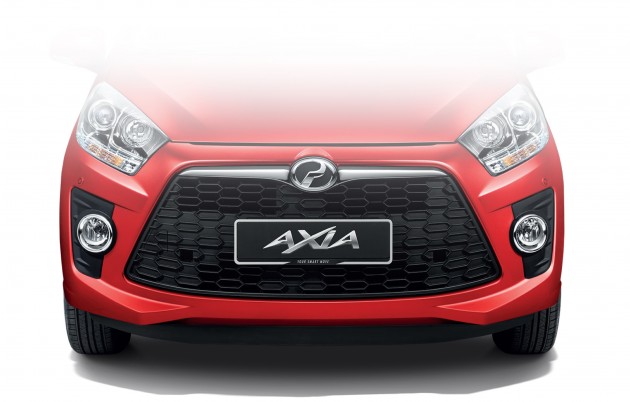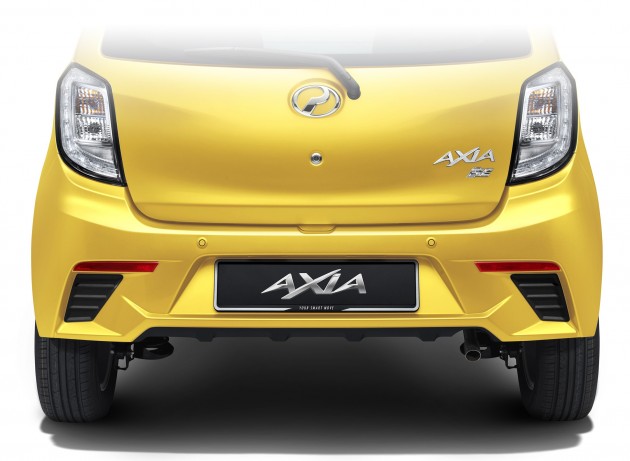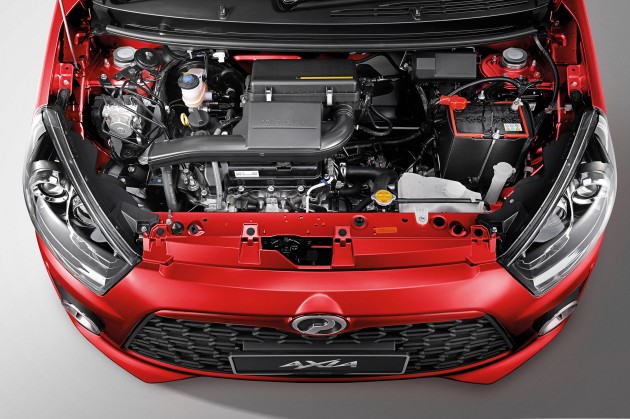
Perodua doesn't launch cars very often, but when it does, it's a big deal. The car of the moment is the Perodua Axia, an A-segment five-door hatchback that effectively replaces the seven-year old Viva as Malaysia's cheapest set of wheels, although the Viva 850 will still be made. With four variants available from RM24,900, the Axia is set to be a hot seller and a familiar face.
Two significantly different faces are on offer, the standard face for the E and G and an aggressive mug for the SE and Advance - one friendly, the other angry. No 660 and 850 this time, all Axias are powered by a 1.0 litre three-cylinder engine with 66 hp and 90 Nm. The 1KR-DE2 is mated to a five-speed manual (21.6 km/l NEDC combined cycle) and a four-speed auto (20.1 km/l). View the full spec breakdown and more info.
Thanks to a media preview session this afternoon, we've seen and sampled the Axia in full production spec. With an embargo in place, we can't show you pics from today's event, but can share with you our first impressions of Malaysia's first energy efficient vehicle (EEV). Three opinions, one agreement - the Axia is pretty impressive.
Danny says
I think everyone can agree that the extremely popular Myvi is a well-packaged car, offering big space in a small footprint, but Perodua has outdone itself here.
The Axia is an A-segment car, but cabin length and width eclipses that of the Myvi, so the Kia Picanto and Mitsubishi Mirage are easy foe. Rear legroom is very, very impressive, and headroom is adequate. We also saw four cabin trolley bags stuffed into the 260-litre boot upright, clearing the parcel shelf, and with width to spare.
In my mid-spec manual tester, the Axia's new engine offers decent go in conjunction with the stick shift, which has a light clutch and long throw. Not great, but not uncommon in the budget car arena either.
Engine refinement is miles better than in the Viva, and overall level of rolling noise is lower too. Contributing to the cause are low rolling resistance Hankooks, which still provided decent grip on damp tarmac. Factors that discourage "spirited" driving are a slow steering (good turning radius doesn't come free) and copious amounts of body roll, but there's strange joy in driving an econobox hard, for me at least.
The Axia effectively takes over the "cheapest car in Malaysia" title from the Viva, but it's a much-improved product with a superior package (four-star ASEAN NCAP, five-year warranty). With this, the baseline is raised, and Malaysian motorists are the winners.

Jonathan says
The Perodua Axia is an unassuming little car with quite a number of surprises tucked up its sleeves. Never mind that its diminutive dimensions belie the considerable space within, or its impressive claimed fuel economy figures - Perodua's 10th model definitely possesses some welcome talents on the move.
At idle, very little is heard from the 1.0 litre three-cylinder engine, whether inside or outside. Move off and some vibration is palpable at low revs, but it quickly settles into a steady, muted rhythm. Venture beyond half-throttle and the ensuing din intrudes into the cabin as the revs climb; rough-sounding and just about adequately contained.
Otherwise, the new aluminium powerplant offers smooth performance across most of the rev range, definitely better than you'd expect for a three-banger. Delivery didn't seem completely linear, though; there were a couple of instances where I felt a distinct shift on higher throttle loads. Is there enough go? Yes, there is - you'd be seriously nitpicking to deem the Axia underpowered.
For a city car, the steering is in fact weightier than expected, and there's not much feel to speak of. It's rather low-geared as well, so on tighter bends you may find yourself needing to turn the wheel more than necessary. But you get a tight 4.5-metre turning radius, so I suppose something's got to give.
Body roll is considerable, but the Axia grips surprisingly well despite its skinny Hankook Kinergy Ex low-rolling resistance tyres, and road noise is very low indeed. The ride is on the soft side - the car deals with undulations well, and rebound is sufficiently damped, too. I found the fabric seats comfortable, but in truth, you never really know for sure until you take a long journey in them.
The four-speed E-AT auto gearbox's gearchanges are not at all rapid, but they are very smooth. Suffice to say, the auto requires a little more pedal work for swift progress than the five-speed manual, which clearly frees up a lot of life in the Axia.
Along with a more immediate throttle and evenly-spaced ratios, this made the car pretty enjoyable to drive. The gear lever has an abundance of free play and the change action could be notchier and less vague, but the clutch pedal is not too light nor too heavy, and its gradual bite point makes jerk-free gearchanges a doddle.

Hafriz says
Let me start by saying that the press test drive wasn't much of a drive at all. It was more of a five-minute taster of the upcoming Perodua Axia. As expected, there's not much to write home about in the driving department, but really, that's fine for a cheap and small city car.
The new all-aluminium engine makes itself heard right away (it's a three-pot after all), but it pulls decently enough, and the car feels light on its feet (because it is). Even more compelling is the ride quality - Perodua has managed to make the Axia ride in a much more sophisticated manner than the Viva. The real highlight here, however, is elsewhere.
Interior space is nothing short of incredible. Now here's an A-segment car from the outside, but with a cabin that could rival all but the most spacious of B-segmenters. Four up in the sub-four metre hatchback, there's plenty of room between all occupants. And it's not like they've sacrificed boot space for it either – its Myvi-beating 260-litre cargo room proves otherwise.
Take my word for it - there's probably more legroom in the Axia than there is in the Myvi. Perhaps the seat backs are thinner. Or maybe the dashboard has been pushed further forward. Either way, the result is just amazing. Compared to the Viva, the new car is a massive leap forward in terms of cabin space.
Well actually, it's a massive leap forward, period. Nothing that we discovered from the short drive would suggest otherwise. It's slightly smoother to drive (though the manual is still rather rough and imprecise, and the auto prone to introduce slight vibrations at idle), far more comfortable to be in (through vastly improved perceived quality and space), and most crucial of all, it offers significantly more value than the Viva ever did.
So it's off to a good start, then? Based on the (very) short taster, yes. But let not this be your be-all and end-all reference for the new Perodua. Once given some proper seat time, we'll have a thorough review of the Axia. Only then will we see if it'll hold up well for more than five minutes, and if its impressive efficiency claims (20.1 to 21.6 km per litre) are anywhere near achievable in the real world.
For now, you have plenty of reasons to be excited. Not bad, Perodua. Not bad at all.



No comments:
Post a Comment